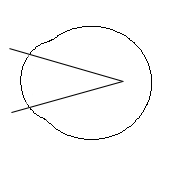It’s all over the radio these days a LASIK surgeon touts “some experts believe LASIK is safer than contact lenses”. In reality this is a difficult statement to backup properly, given that we are really comparing apples to oranges. Why is this comparison difficult? Comparing LASIK to another refractive surgery procedure, such as PRK, is rather straight forward because the complications are similar for both procedures and the opportunity for complications is essentially nil after the patient is stable, typically 6 months to a year after surgery. A contact lens wearer, on the other hand, has a lower complication rate. When compared to LASIK or PRK contact lens complications are less severe and less frequent, however, a contact lens wearer’s potential for complications will last as long as the patient is wearing their lenses, often for decades.
Both LASIK and contact lenses are safe and in our office we utilize both techniques, choosing which is best for the patient. It is our practice to discuss all of the refractive options with our patients. We weigh the risks and benefits of each option before proceeding.
As a practical matter the incidence of vision threatening problems in compliant contact lens wearers is very small. When a patient does have a problem, it typically manifests itself as a red eye usually resulting from poor care or not replacing their contacts as often as recommended. It is exceedingly rare for a contact lens related red eye to cause a patient to require surgery to resolve the problem.
This prompts me to ask “what does the research say”. In my mind that’s what matters. Let the studies show us which is safer. The most important contact lens and LASIK complications are those that have resulted in a loss of vision and therefore that is the best criteria to compare LASIK versus extended wear contact lenses. A 2005 study including almost 5,000 patients followed over a 1 year period showed that 30 day Ciba Night & Day contact lens wearers, experienced an overall rate of presumed infiltrative keratitis (a type of corneal ulcer) of 0.18%. Of those experiencing keratitis 0.036% resulted in a loss of vision and 0.144% experienced keratitis without vision loss.
Numerous studies published in 2005 and 2006 indicated a complication rate for LASIK, resulting in a loss of best corrected vision, ranging from 0.6% to 7.0%.
Given the facts outlined above, I feel it is doing patients a disservice to state or imply that refractive surgery is as safe or safer than silicone hydrogel contact lenses. Both LASIK/PRK and silicone hydrogel contact lenses have come a long way in reducing both the rate and severity of complications and in looking at the numbers both are safe.
I still believe LASIK and PRK are good options for patients. I, in fact, have had LASIK and at our office it is still one of the refractive options we present to our patients. However, the research does not support the statement that refractive surgery is as safe as contact lens wear nor should it be promoted as such.
Technorati Tags: Extended Wear, Laser Vision Correction, LASIK, Refractive Surgery, Contact Lenses, Safety

